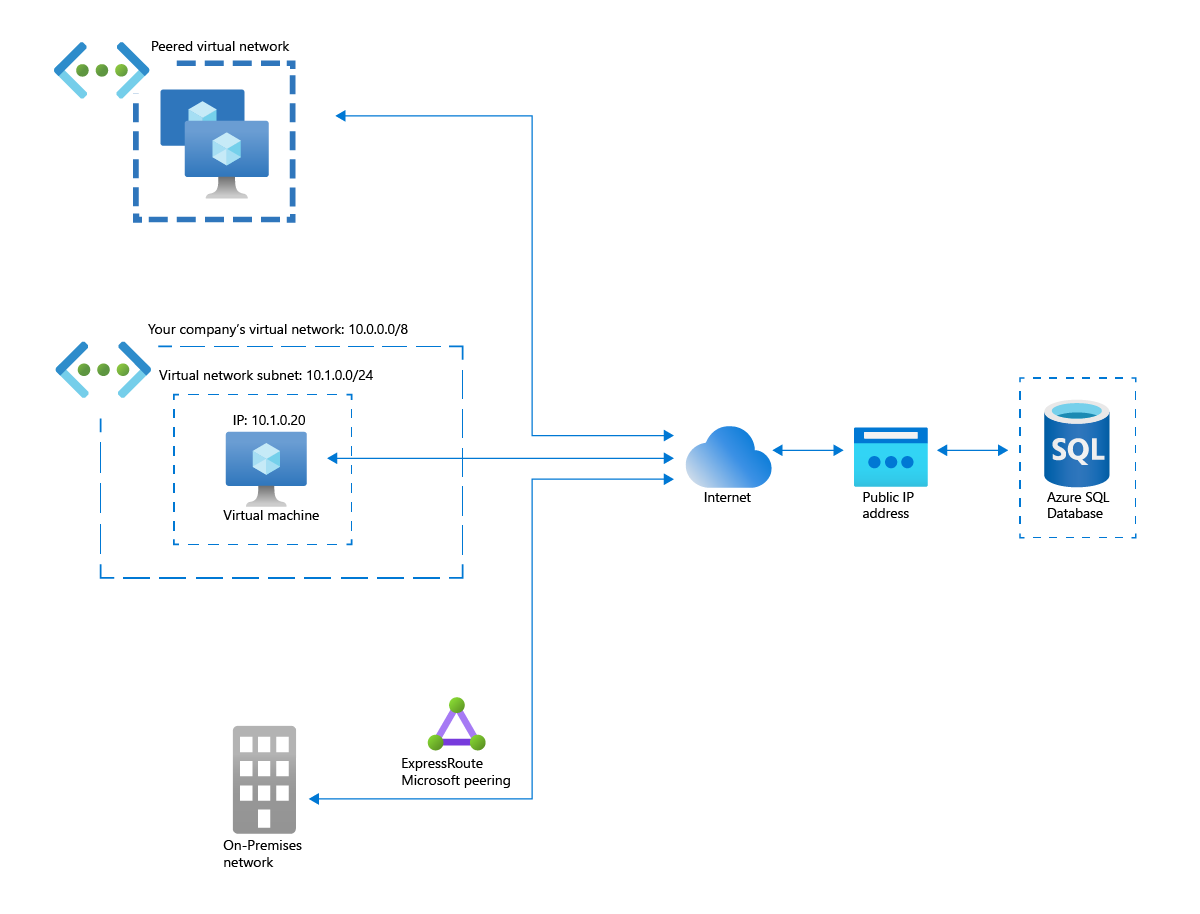What is Azure Private Link?
Before you learn about Azure Private Link and its features and benefits, let's examine the problem that Private Link is designed to solve.
Contoso has an Azure virtual network and wants to connect it to a PaaS resource such as an Azure SQL database. When you create such resources, you normally specify a public endpoint as the connectivity method.
Having a public endpoint means that the resource is assigned a public IP address. So, even though both your virtual network and the Azure SQL database are located within the Azure cloud, the connection between them takes place over the internet.
The problem is that your Azure SQL database is exposed to the internet via its public IP address. That exposure creates multiple security risks. The same security risks are present when an Azure resource is accessed via a public IP address from the following locations:
- A peered Azure virtual network
- An on-premises network that connects to Azure using ExpressRoute and Microsoft peering
- A customer's Azure virtual network that connects to an Azure service offered by your company

Private Link is designed to eliminate these security risks by removing the public part of the connection.
Overview of Private Link
Private Link provides secure access to Azure services. Private Link achieves that security by replacing a resource's public endpoint with a private network interface. There are three key points to consider with this new architecture:
- The Azure resource becomes, in a sense, a part of your virtual network.
- The connection to the resource now uses the Microsoft Azure backbone network instead of the public internet.
- You can configure the Azure resource to no longer expose its public IP address, which eliminates that potential security risk.
What is Azure Private Endpoint?
Private Endpoint is the key technology behind Private Link. Private Endpoint is a network interface that enables a private and secure connection between your virtual network and an Azure service. In other words, Private Endpoint is the network interface that replaces the resource's public endpoint.
Note
Private Endpoint isn't a free service. You pay a set fee per hour, and a set fee per gigabyte for both inbound and outbound traffic that passes through the Private Endpoint.
What is Azure Private Link Service?
Private Link gives you private access from your Azure virtual network to PaaS services and Microsoft Partner services in Azure. However, what if your company creates its own Azure services for your company's customers to consume? Is it possible to offer those customers a private connection to your company's services?
Yes, by using Azure Private Link Service. This service lets you offer Private Link connections to your custom Azure services. Consumers of your custom services can then access those services privately—that is, without using the internet—from their own Azure virtual networks.
Note
There's no charge to use Private Link Service.
Key benefits of Private Link
Private Link working together with Private Endpoint and Private Link Service provides the following benefits:
- Private access to PaaS services and Microsoft Partner services on Azure. When you use Private Endpoint, Azure services are mapped to your Azure virtual network. It doesn't matter that the Azure resource is in a different virtual network and in a different Active Directory tenant. To users in your Azure virtual network, the resource appears to be part of that network.
- Private access to Azure services in any region. Private Link works globally. The private connection to an Azure service works even if that service's virtual network is in a different region than your own virtual network.
- Nonpublic routes to Azure services. Once an Azure service is mapped to your virtual network, the traffic route changes. All inbound and outbound traffic between your virtual network and the Azure service travels over the Microsoft Azure backbone network. The public internet is never used for service traffic.
- Public endpoints are no longer required. Because all traffic to and from a mapped Azure service now flows over the Microsoft Azure backbone, the public endpoint for the service is no longer required. You can disable that public endpoint and therefore eliminate a possible security threat.
- Your peered Azure virtual networks also get access to Private Link-powered resources. If you're using one or more peered Azure virtual networks, no extra configuration is needed for those peered networks to access a private Azure resource. Clients within any peered network can access whatever Private Endpoint you map to an Azure service.
- Your on-premises network also gets access to Private Link-powered resources. Does your on-premises network connect to your Azure virtual network using either ExpressRoute private peering or a VPN tunnel? If so, no extra configuration is needed for clients within the on-premises network to access a private Azure resource.
- Protection against data exfiltration. When you map a Private Endpoint to an Azure service, you map to a specific instance of that service. For example, if you're setting up private access to Azure Storage, you map the access to a blob, table, or other storage instance. If a virtual machine in your network gets compromised, the attacker can't move or copy data to another resource instance.
- Private access to your own Azure services. You can implement Private Link Service and offer customers private access to your custom Azure services.
Private Link availability
Private Link and Private Endpoint work with many Azure services. To keep up to date on the latest services and regions that support Private Link, refer to Azure updates.